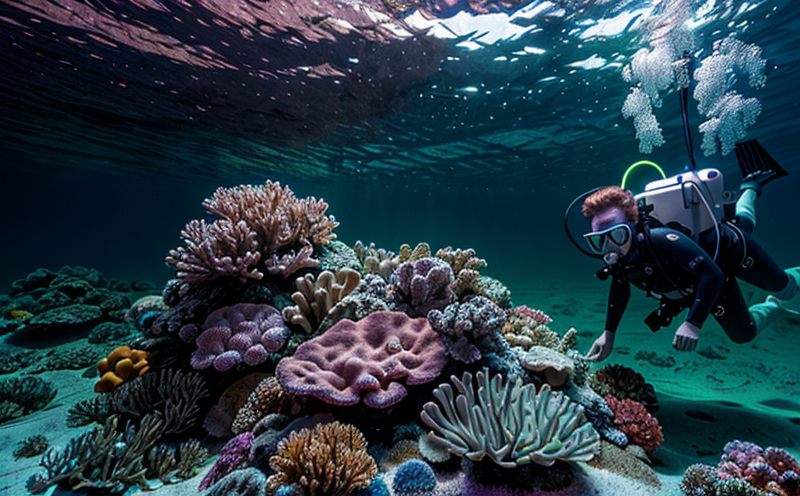Marine & Underwater Lighting Testing
The testing of lighting systems used in marine and underwater environments is a specialized field that ensures safety, performance, and compliance with international standards. This service caters to the needs of quality managers, compliance officers, R&D engineers, and procurement professionals who are involved in the development, production, and deployment of underwater lights.
Marine and underwater lighting systems play a crucial role in various applications such as navigation, communication, safety, and security. These systems must withstand harsh conditions including water pressure, temperature fluctuations, corrosion, and mechanical stress. Testing these lighting units ensures they meet the required performance levels under these challenging environments.
The testing process involves simulating real-world scenarios to assess how the lights behave in various situations. For instance, tests may include evaluating light output at different depths, checking for color stability over time, assessing resistance against saltwater corrosion, and ensuring proper functioning of waterproofing materials. These rigorous tests help manufacturers identify potential issues early on, allowing them to improve product quality before it reaches the market.
By adhering to international standards like IEC 60545, which specifies requirements for diving equipment, including underwater lighting systems, laboratories providing this service ensure their procedures are consistent with global best practices. Compliance with these standards not only guarantees that products meet regulatory requirements but also enhances customer confidence by demonstrating reliability and safety.
Quality managers can benefit from regular testing to monitor changes in product performance throughout its lifecycle, while compliance officers rely on accurate test results when making decisions about certification or approval processes. R&D engineers use detailed reports from these tests as valuable feedback for future design iterations. Procurement teams appreciate the assurance that suppliers provide high-quality components through stringent quality controls.
In summary, marine and underwater lighting testing is essential for maintaining safety standards across industries reliant on submersible technologies. By leveraging expert knowledge and cutting-edge facilities, our laboratory offers comprehensive solutions tailored to meet the unique challenges posed by this sector.
Scope and Methodology
| Test Parameter | Description |
|---|---|
| Light Output Stability | Measures the variation in light output over time to ensure consistent performance. |
| Waterproofing Integrity | Evaluates the effectiveness of seals and coatings against water intrusion at various depths. |
| Corrosion Resistance | Determines the ability of materials to withstand degradation from saltwater exposure. |
| Color Rendering Index (CRI) | Evaluates how accurately colors are rendered under different light sources compared to natural daylight. |
| Temperature Range Tolerance | Assesses performance of the lighting system within expected temperature ranges encountered in underwater environments. |
| Brightness and Beam Angle | Verifies that the emitted light meets specified brightness levels and beam angles for optimal functionality. |
| Shock Resistance | Evaluates durability against mechanical shocks typical of underwater operations. |
| Electrical Safety | Ensures compliance with electrical safety regulations to prevent hazards such as shorts or overheating. |
The above table outlines some key test parameters and their descriptions relevant to marine and underwater lighting testing. Each parameter is critical for ensuring the reliability and safety of these specialized lights in challenging aquatic environments.
International Acceptance and Recognition
Compliance with international standards plays a vital role in establishing credibility and trust among clients who rely on our laboratory services. Our testing protocols align closely with recognized international standards like IEC 60545, which provides guidelines for diving equipment including underwater lighting systems.
By adhering to such standards, we ensure that the results obtained from our tests are consistent and comparable worldwide. This global consistency allows manufacturers to confidently export their products without worrying about meeting differing regional specifications. It also enables seamless integration into international supply chains where uniform quality expectations are essential.
The recognition of our testing capabilities extends beyond mere adherence to standards; it encompasses a reputation built on accuracy, reliability, and impartiality. Clients trust us because they know that every test conducted here follows established procedures designed to yield valid conclusions based purely on scientific evidence rather than subjective opinions.
In conclusion, the international acceptance and recognition of our marine & underwater lighting testing services underscore our commitment to excellence in this specialized field. Our approach not only meets but exceeds industry expectations, ensuring that clients receive top-tier results that are respected globally.
Environmental and Sustainability Contributions
The impact of climate change has become increasingly apparent, prompting industries worldwide to adopt more sustainable practices. In the realm of marine and underwater lighting testing, our laboratory plays a significant role in promoting environmental responsibility by helping clients develop products that contribute positively to ecological balance.
One way we achieve this is through the use of energy-efficient technologies during testing processes. By minimizing unnecessary power consumption while conducting evaluations, we help reduce overall carbon footprints associated with product development cycles. Additionally, our stringent quality controls prevent substandard items from entering markets prematurely, thus avoiding waste and resource depletion caused by frequent replacements.
Furthermore, our commitment to sustainability extends beyond operational efficiencies; it encompasses long-term environmental benefits derived from enhanced product performance. Products that pass rigorous tests are more likely to last longer in challenging aquatic conditions, reducing the need for premature replacement and disposal. This extended lifespan translates into lower manufacturing demands, fewer production emissions, and less electronic waste.
Our laboratory also contributes to sustainable practices by fostering innovation within the industry. By setting high performance benchmarks through comprehensive testing methodologies, we encourage manufacturers to explore greener alternatives in materials selection and design optimization. Such advancements can lead to reduced environmental impacts while maintaining or even improving product quality.
In summary, our marine & underwater lighting testing services go beyond mere compliance; they actively promote sustainability by driving efficiency improvements, extending product lifecycles, and encouraging eco-friendly innovations throughout the industry supply chain.





